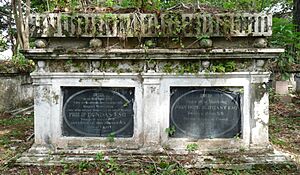Philip Dundas facts for kids
Philip Dundas was a Scottish man who lived a busy life in the late 1700s and early 1800s. He worked for the East India Company, which was a powerful trading company. He was a naval officer and later became a leader in Bombay, India. After returning to Britain, he became a member of Parliament. He then traveled back to Asia to become the governor of Prince of Wales Island, which is known today as Penang.
Contents
Early Life and Family Background
Philip Dundas was born in Scotland in 1762. He was the fourth son of Robert Dundas and Jean Grant. His family was quite well-known in Scotland.
Working for the East India Company
The East India Company was a huge British trading company that operated in India and other parts of Asia. Philip Dundas joined their navy and became a captain of a ship called Melville Castle from 1786 to 1792.
Thanks to his uncle, Henry Dundas, 1st Viscount Melville, who had important political connections, Philip was promoted. He became the head of the Marine Board and a superintendent in Bombay (a major city in India) from 1792 to 1801. This was a very important job, and he earned a lot of money during this time. He saved enough to return to England.
Becoming a Member of Parliament
When Philip Dundas came back to Britain, he decided to enter politics. He became a Member of Parliament (MP) for an area called Gatton in England. An MP is someone elected to represent people in the country's government. He won his seat in 1803, even though it was a very close election.
He was an MP for about two years. During this time, he didn't speak much in Parliament. However, he voted with his family members on important decisions, including those that led to a change in the government leadership. In 1805, he left his position as an MP.
Governor of Prince of Wales Island
Soon after leaving Parliament, Philip Dundas set sail for the East Indies again. This time, he was going to be the Governor of Prince of Wales Island, which is now known as Penang in Malaysia. His uncle had hoped to set up a naval base there.
He arrived at Prince of Wales Island in September 1805. He brought his team of officials, including a young man named Stamford Raffles, who would later become very famous for founding Singapore.
At this time, Penang was a very important place for the British East India Company. It was considered as important as the three main areas in India: Calcutta, Madras, and Bombay. Philip Dundas served as Governor of Prince of Wales Island from 1805 until 1807.
Sadly, Philip Dundas became ill and passed away on April 8, 1807, while on a ship in the Bay of Bengal. He had only been governor for two years. He was buried in Penang a few days later.
Family Life
Philip Dundas was married twice. His first wife was Penelope Ford Lindsay, whom he married in 1790. She passed away in 1802, and they did not have any children.
In 1803, he married Margaret Wedderburn. They had two sons:
- Robert Adam, who later became a Conservative Member of Parliament.
- Philip Dundas (1806–1870), who became a colonel in the army. He married Lady Jane Charteris in 1858. They are buried together in Scotland and did not have children.
Ships Named After Him
At least three ships were named in honor of Philip Dundas. You can learn more about one of them here: Philip Dundas.


